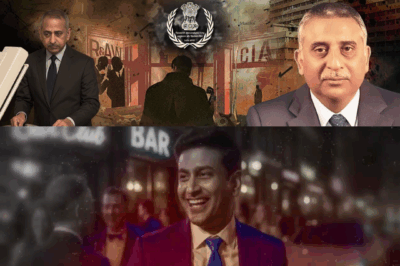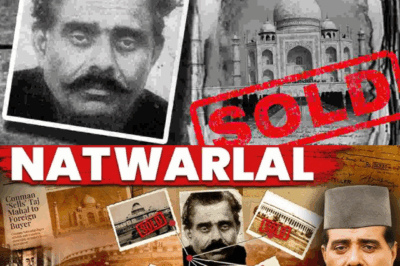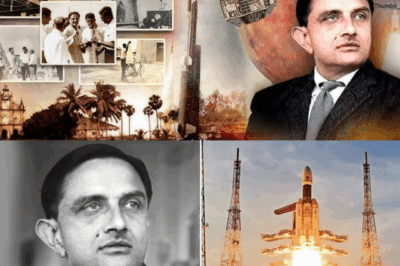In the dusty streets of Khanapur, a small town in Karnataka, a young fruit seller once stood beneath the harsh Indian sun, shouting prices and chasing after coins that rolled into the dirt. His name was Abdul Karim Telgi — a man no one could have imagined would one day bring the Indian legal system to its knees. He wasn’t born into wealth or privilege, but he was born with something far more dangerous — the ability to see cracks in the system, and the courage to crawl through them.
Telgi’s story is not just about money or crime. It is about the terrifying genius of a man who understood how the machinery of law, politics, and power truly worked — and how easily it could be manipulated. His journey from a poor salesman to the mastermind behind one of the biggest financial frauds in India’s history is both fascinating and disturbing.
It all began in the 1980s, when Telgi moved to Saudi Arabia in search of work. Like millions of Indians, he dreamed of a better life abroad. But even there, fate had different plans. After a few years, he returned to India, restless and disillusioned. That restlessness soon turned into ambition — and then, obsession.
He started small, forging passports and fake travel documents for workers who wanted to go abroad. The money was good, but Telgi wanted more. He had realized something profound — people trusted documents more than they trusted people. A piece of paper with a government seal could open any door. And if you could make that paper, you could own the system.
It was that realization that birthed what would later be known as The Telgi Scam.
In India, every major financial transaction — from property deals to court cases — required an official stamp paper, issued by the government. The system was bureaucratic, slow, and deeply corrupt. Somewhere inside that maze, Telgi saw his golden opportunity. He decided to forge those stamp papers, not in small numbers, but on an industrial scale.
He began by bribing officials in the Security Press — the only place authorized to print stamp papers. Using his charm and connections, he managed to get his hands on genuine printing plates, inks, and watermarked paper. What he created next was indistinguishable from the real thing. It was not a copy — it was a clone.
Within a few years, Telgi had built an underground empire. His fake stamp papers flooded banks, courts, insurance companies, and even government offices. It wasn’t just a few forged sheets — it was billions worth of fake documents circulating through the veins of India’s economy. And almost no one noticed.
He operated through a web of distributors across several states, using middlemen, corrupt officials, and local politicians. The scam grew so large that at one point, genuine and fake stamp papers were practically identical in circulation. Nobody could tell which was which — not even the police.
By the late 1990s, Telgi’s fake empire had spread across Maharashtra, Gujarat, Karnataka, and Delhi. He had everything — luxury cars, houses, connections with ministers, and a personal fortune running into billions of rupees. But the most astonishing part? He didn’t hide in shadows. He attended parties, funded political campaigns, and mingled with the elite.
He knew one truth — in India, money buys silence faster than fear.
The scam might have gone on forever if not for a single slip. In 2000, a police raid in Mumbai uncovered a massive stockpile of fake stamp papers. The investigation led straight to Telgi’s network. At first, authorities dismissed it as another forgery racket. But as they dug deeper, the magnitude of the fraud began to unfold.
The numbers were staggering — fake stamp papers worth more than ₹30,000 crore (about $4 billion) had circulated across India. Dozens of government departments, banks, and even the judiciary had used forged documents without knowing. The very foundation of trust in the Indian legal system had been compromised.
The truth hit the nation like a thunderclap. How could one man cheat an entire country — and for so long?
As the investigation widened, shocking revelations emerged. Politicians, police officers, and bureaucrats were all found to be on Telgi’s payroll. He had bought protection from every direction. Many who were supposed to stop him were the same people helping him grow. The corruption ran so deep that the case began to look less like a scam and more like a mirror reflecting India’s broken governance.
When Telgi was finally arrested in 2001, the public expected justice. But even behind bars, he controlled his empire. Prison guards served him meals from five-star hotels, and visitors were screened through bribes. It was said that Telgi once smirked and told the police, “Why are you chasing me? You should be chasing yourselves.”
That quote summed up everything the Telgi scam stood for — not the brilliance of one man, but the failure of a system designed to be foolproof.
The courtroom scenes that followed were surreal. Telgi appeared calm, polite, even witty. He didn’t deny his crimes. Instead, he justified them. He claimed that his fake stamp papers filled a demand that the government couldn’t meet. “If I didn’t do it,” he once told investigators, “someone else would have.”
It was the argument of a man who didn’t see himself as a criminal, but as a businessman operating in a corrupt market.
Over time, as the scandal deepened, more than 70 people were arrested — including senior police officials, ministers, and bureaucrats. The government faced national outrage. Investigations exposed an entire chain of bribery, forgery, and greed that spanned the country.
Telgi’s fortune crumbled, but his legend grew. He became a symbol — not just of crime, but of India’s vulnerability to corruption.
In 2006, after years of trials, he was sentenced to 30 years in prison. But by then, his health had deteriorated. He was diagnosed with meningitis, diabetes, and multiple other illnesses. In 2017, Abdul Karim Telgi died in a Pune hospital, leaving behind unanswered questions — and a system forever marked by his shadow.
But even after his death, the echoes of his fraud continued. Court cases dragged on for years, new names emerged, and millions of fake stamp papers were still found in circulation. His empire, though dismantled, had left a permanent scar on India’s legal and financial structure.
What made the Telgi scam so haunting wasn’t just the money — it was the philosophy behind it. Telgi didn’t invent corruption. He simply mastered it. He exploited the trust that people placed in government paper, in seals, in signatures — the very tools meant to ensure justice.
He turned bureaucracy into a weapon.
To this day, people still debate whether Telgi was a villain or a genius. Some call him India’s most dangerous criminal. Others call him a reflection of the times — a man who understood that in a country where rules were for the powerless, power itself was the ultimate loophole.
His story has been immortalized in books, documentaries, and series like Scam 2003: The Telgi Story, which captures the chilling brilliance behind the man who forged not just documents, but destiny itself.
When you peel back the layers of the Telgi scam, you don’t just find one man’s greed. You find an entire system built on weak foundations — one that trusted paperwork more than people, power more than integrity. Telgi didn’t break India’s system. He simply showed the world that it was already broken.
And that may be his most dangerous legacy of all.
News
The Man Who Sold India’s Secrets: Inside R&AW’s Biggest Betrayal
It began with silence.A silence so heavy it could crush even the most disciplined hearts inside India’s most secretive walls…
Natwarlal: The Conman Who Sold the Taj Mahal — Thrice!
He was not a gangster, not a killer, not even a man with an army. Yet his name sent shivers…
Vikram Sarabhai: The Visionary Who Took India to Space
The night was quiet over Ahmedabad in 1947 when a young man stood on the terrace of his home, staring…
Bigg Boss 19 New Promo: Entire House Turns Against Malti During Explosive Task
The night began like any other inside the Bigg Boss 19 house. Laughter, teasing, and quiet strategy whispers filled the…
Bigg Boss 19 LIVE: Mitali Reads Tanya’s Palm and Reveals a Shocking Truth That Stuns the House
The night was quiet inside the Bigg Boss 19 house. The lights were dim, the laughter had faded, and the…
Bigg Boss 19 New Promo: Housemates Face Shocking Task as Experts Step In with Bold Advice
The lights dim, the siren blares, and the voice of Bigg Boss echoes through the house. “Time for the next…
End of content
No more pages to load












